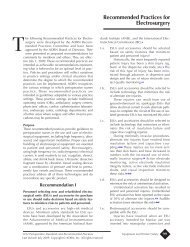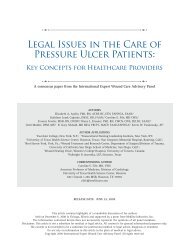2009 CAUTI guidelines - Centers for Disease Control and Prevention
2009 CAUTI guidelines - Centers for Disease Control and Prevention
2009 CAUTI guidelines - Centers for Disease Control and Prevention
You also want an ePaper? Increase the reach of your titles
YUMPU automatically turns print PDFs into web optimized ePapers that Google loves.
Very low-quality evidence suggested a benefit of intermittent over suprapubic catheterization inselected populations 115,116,134-136 based on increased patient acceptability <strong>and</strong> decreased risk ofurinary complications (bladder calculi, vesicoureteral reflux, <strong>and</strong> upper tract abnormalities).Although we found a decreased risk of bacteriuria/unspecified UTI with suprapubiccatheterization, there were no differences in SUTI. The populations studied included womenundergoing urogynecologic surgery <strong>and</strong> spinal cord injury patients.Q2A.4. Suprapubic versus indwelling urethralLow-quality evidence suggested a benefit of suprapubic catheters over indwelling urethralcatheters in selected populations. 37,62,104,107,108,128-133,135,136 This was based on a decreased risk ofbacteriuria/unspecified UTI, recatheterization, <strong>and</strong> urethral stricture, <strong>and</strong> increased patientcom<strong>for</strong>t <strong>and</strong> satisfaction. However, there were no differences in SUTI <strong>and</strong> an increased risk oflonger duration of catheterization with suprapubic catheters. Studies involved primarilypostoperative <strong>and</strong> spinal cord injury patients. Our search did not reveal data on differences incomplications related to catheter insertion or the catheter site.Q2A.5. Clean intermittent versus sterile intermittentModerate-quality evidence suggested no benefit of using sterile over clean technique <strong>for</strong>intermittent catheterization. 63,73,105,117-122 No differences were found in the risk of SUTI orbacteriuria/unspecified UTI. Study populations included nursing home residents <strong>and</strong> adults <strong>and</strong>children with neurogenic bladder/spinal cord injury.Evidence Review Table 2A. What are the risks <strong>and</strong> benefits associated with differentapproaches to catheterization?2A.1. Consider using external catheters as an alternative to indwelling urethral catheters incooperative male patients without urinary retention or bladder outlet obstruction. (Category II)2A.2. Intermittent catheterization is preferable to indwelling urethral or suprapubic catheters inpatients with bladder emptying dysfunction. (Category II)2A.3. If intermittent catheterization is used, per<strong>for</strong>m it at regular intervals to prevent bladderoverdistension. (Category IB)2A.4. For operative patients who have an indication <strong>for</strong> an indwelling catheter, remove thecatheter as soon as possible postoperatively, preferably within 24 hours, unless there areappropriate indications <strong>for</strong> continued use. (Category IB)*2A.5. Further research is needed on the risks <strong>and</strong> benefits of suprapubic catheters as analternative to indwelling urethral catheters in selected patients requiring short- or long-termcatheterization, particularly with respect to complications related to catheter insertion or thecatheter site. (No recommendation/unresolved issue)2A.6. In the non-acute care setting, clean (i.e., non-sterile) technique <strong>for</strong> intermittentcatheterization is an acceptable <strong>and</strong> more practical alternative to sterile technique <strong>for</strong> patientsrequiring chronic intermittent catheterization. (Category IA)* More data are available under Question 2C38
















